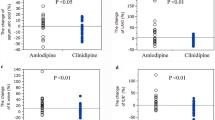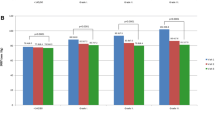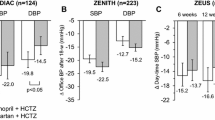Summary
Several β-blockers increase VLDL-TG and decrease HDL-cholesterol concentrations. The underlying mechanism ist not yet clear. Some studies have suggested that the effect is less pronounced during treatment with selective β-blockers. The effects of 2 such drugs, metoprolol 200 mg/day and atenolol 50 mg/day, have been compared in 50 hypertensive patients (WHO Stage I–II), mean age 47 years. Serum lipoproteins were determined in 20 patients before treatment and after treatment with either drug for 3 months. Both drugs were equally effective in reducing blood pressure. After atenolol the initial VLDL-cholesterol concentration of 1.04 mmol/l had not changed, but it rose to 1.29 mmol/l after metoprolol (p<0.05). The HDL-cholesterol concentration 1.42 mmol/l did not fall during atenolol treatment, but during metoprolol there was a small reduction to 1.31 mmol/l (p<0.05). Hyperlipoproteinaemia is common in hypertensive patients, 40% of the present group had hypertriglyceridaemia and 25% had hypercholesterolaemia. Thus, atenolol 50 mg was found not to affect lipoproteins, whereas metoprolol 200 mg increased the VLDL concentration in 75% of the patients.
Similar content being viewed by others
References
Frishman W, Silverman R, Strom J, Elkayam U, Sonnenblick E (1979) Clinical pharmacology of the new beta-adrenergic blocking drugs. Part 4. Adverse effects. Choosing a β-adrenoreceptor blocker. Am Heart J 98: 256–262
Láger I, Smith U (1981) Betablockad och diabetes mellitus. Läkartidningen 78 [8]: 696–699
Rössner S (1982) Serum lipoproteins and ischemic vascular disease: On the interpretation of serum lipid versus serum lipoprotein concentrations. J Cardiovasc Pharmacol 4 [Suppl 2]: S201–205
Johnson BF (1982) The emerging problem of plasma lipid changes during antihypertensive therapy. J Cardiovasc Pharmacol 4 [Suppl 3]: S213–221
Carlson LA, Böttiger LE (1981) Serum triglycerides, to be or not to be a risk factor for ischaemic heart disease? Atherosclerosis 39: 287–291
Miller GJ, Miller NE (1975) Plasma-high-density-lipoprotein concentration and development of ischaemic heart-disease. Lancet 1: 16–19
Eliasson K, Lins L-E, Rössner S (1981) Serum lipoprotein changes during atenolol treatment of essential hypertension. Eur J Clin Pharmacol 20: 335–338
Carlson K (1973) Lipoprotein fractionation. J Clin Pathol 26 [Suppl] 5: 32–37
Lyngstam O, Rydén L (1981) Metoprolol and atenolol administered once daily in primary hypertension. Acta Med Scand 209: 261–266
Wilcox RG, Hampton JR (1981) A comparative study of atenolol, metoprolol durules and slow-release oxprenolol in essential hypertension. Br Heart J 46: 498–502
Thomas GW, Mann JI, Beilin LJ, Ledingham JG (1977) Hypertension and raised serum lipids. Br Med J 2: 805
Östergaard-Kristensen B (1981) HDL-cholesterol, triglycerides and vascular complications in essential hypertension. Acta Med Scand [Suppl] 646: 31–42
Östergaard-Kristensen B (1981) Effect of long-term treatment with beta-blocking drugs on plasma lipids and lipoproteins. Br Med J 283: 191–192
Carlson LA, Ericsson M (1975) Quantitative and qualitative serum lipoprotein analysis. Part I. Studies in healthy men and women. Atherosclerosis 21: 417–433
Kim HJ, Kalkhoff RK (1979) Changes in lipoprotein composition during the menstrual cycle. Metabolism 28: 663–668
Newman RJ (1977) Comparison of the antilipolytic effect of metoprolol, acebutolol, and propranolol in man. Br Med J 2: 601–603
Tanaka N, Sakaguchi S, Oshige K, Niimura T, Kanehisa T (1976) Effect of chronic administration of propranolol on lipoprotein composition. Metabolism 25: 1071–1075
Day JL, Metcalfe J, Simpson CN (1982) Adrenergic mechanisms in control of plasma lipid concentrations. Br Med J 284: 1145–1148
Berglund G, Andersson O (1981) Beta-blockers or diuretics in hypertension? A six year follow-up of blood pressure and metabolic side effects. Lancet 1: 744–747
Pagnan A, Pessina AC, Hlede M et al (1979) Effects of labetalol on lipid and carbohydrate metabolism. Pharmacol Res Commun 11: 227–236
Leren P, Helgeland A, Holme I et al (1980) Effect of propranolol and prazosin on blood lipids. The Oslo Study. Lancet 2: 4–6
Author information
Authors and Affiliations
Rights and permissions
About this article
Cite this article
Rössner, S., Weiner, L. Atenolol and metoprolol: Comparison of effects on blood pressure and serum lipoproteins, and side effects. Eur J Clin Pharmacol 24, 573–577 (1983). https://doi.org/10.1007/BF00542203
Received:
Revised:
Accepted:
Issue Date:
DOI: https://doi.org/10.1007/BF00542203




